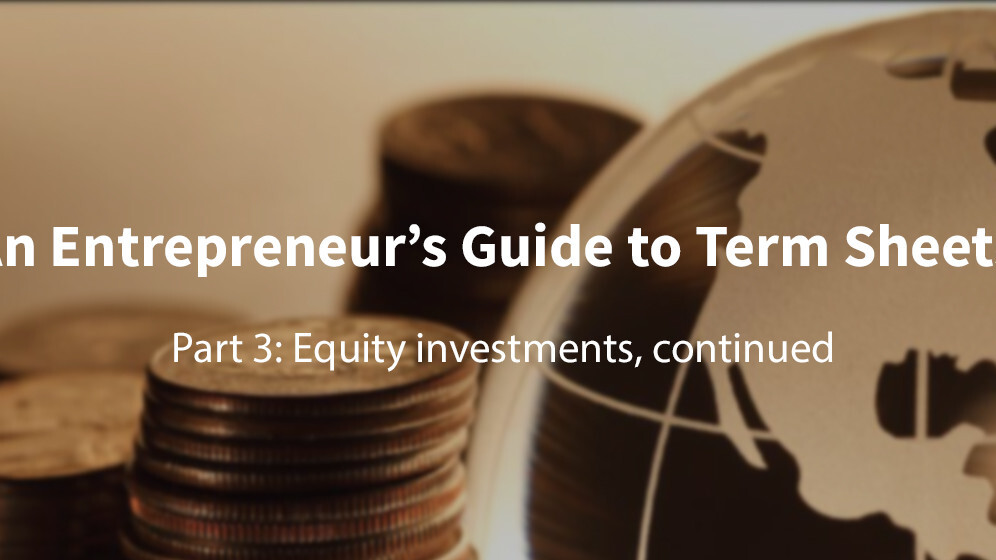
Andrej Kiska is an Associate at Credo Ventures.
If you haven’t read the first part on equity term sheets, I strongly recommend doing so before moving on. For a general introduction to term sheets and the trade-off between high valuation and complex investment structure, please refer to the introductory post to the guide.
Let’s dig into the remaining set of terms entrepreneurs can typically find in an equity-round term sheet, which the first post didn’t cover. They are mostly the complex points, which are often misunderstood and can lead to serious quarrels.
The terms
Liquidation preference: a very important clause that is sometimes overlooked by entrepreneurs. It is one of the key terms used to protect an investor’s downside.
Generally, you will find one of the two variations of the liquidation preference definition in a term sheet: participating or non-participating, or their combination (i.e. capped participating, even though that’s quite rare in my experience).
The easiest way to explain liquidation preference is using an example. Let’s say an investor invested EUR 1,000,000 for 10 percent stake in the company. If this investor has a non-participating liquidation preference, he has a right to choose at a liquidation event (i.e. exit, or any kind of transaction that involves a buy-out of existing shareholders, not just a bankruptcy sale) whether he would like to receive the preferred return specified in the liquidation preference clause or 10 percent of the exit price.
Most typically, the preferred return is equal to the amount invested (in our example EUR 1,000,000), but can be a multiple of that amount (e.g. 2x liquidation preference corresponds in our example to EUR 2,000,000).
Let’s say the investor in our example has 1x (also called “simple”) liquidation preference, i.e. EUR 1,000,000. When the company gets sold, he can choose whether he would like to receive EUR 1,000,000 or 10 percent of the exit price.
Using simple math, it makes sense to choose EUR 1,000,000 if the exit price is below EUR 10,000,000, and choose 10 percent of the company if the exit price is above EUR 10 MM.
Likewise, if the investor has 2x liquidation preference (and thus his preferred return is EUR 2,000,000), the exit price at which it becomes interesting to take the 10 percent of the company instead of the preferred return is EUR 20 MM.
Things get a bit more complicated with participating liquidation preference. In this scenario, the investor at exit first gets his preferred return, and then the rest of the exit proceeds get distributed pro rata among all shareholders.
Let’s take the example above: investor has provided EUR 1 MM for 10 percent of the company with 1x participating liquidation preference. If the company gets sold for EUR 10,000,000, the investor first gets EUR 1 MM, and then also 10 percent of the remaining EUR 9 MM for a total of EUR 1.9 MM.
In general, we tend to stick with simple 1x non-participating liquidation preference, which is the most entrepreneur-friendly alternative. Entrepreneur-friendly liquidation preference is also important for attracting future investors or exit partners, who don’t want to see a disproportionate amount of acquisition price going to investors as opposed to entrepreneurs.
Nonetheless, if the entrepreneur has unreasonable valuation expectations, we tend to include stricter liquidation preference (2-3x non participating). Personally, we consider it too entrepreneur-unfriendly. If we can’t reach an agreement on acceptable valuation, we would prefer to walk away from a deal rather than include harsh terms that can cause fights between founders and an investor and deter future investors from investing.
Drag along right: this right allows an investor (or, in case a startup has multiple investors, after agreement among all existing investors) to drag all remaining shareholders (including the founders) to sell their shares if the investor decides to sell his.
Typically, this right can only be exercised after certain time period; standard is between 1-3 years after the transaction. Sometimes, the execution of a drag along right has to be approved by startup’s board of directors.
A lot of entrepreneurs worry about this right and it is easy to see why. At first glance, it seems that the investor can decide the fate of the company without consulting the founders. What the founders must realize is that no buyer will buy a company if they don’t want to sell, because the founders and their team are an essential part of what the acquirer is buying.
That’s why a drag along can only work in practice if it also endorsed by the founders. We at Credo have never exercised a drag along right before, but still want to have it in the term sheet. It is for the unlikely event that some shareholder (typically a non-essential one, such as a fired angry early employee who has a stake in the company and wants to damage it) will try to block a transaction.
Founder’s vesting: another right that deals with founder quarrels. Essentially, when founders take an outside investment, they will not own their entire equity outright. Instead, it will vest over time. If you are not sure what vesting is, please read Fred Wilson’s post.
Let’s describe the mechanics in an example. Our typical terms are the following: at signing, each founder directly owns 30 percent of his stake. The remaining 70 percent of the stake gets vested over the next 4 years.
How does this look in practice? Let’s say a founder is supposed to own 50 percent of the company once the investment is made. According to founder’s vesting, he will own 50 percent * 30 percent = 15 percent of the company outright. In two years, he will own 50 percent *30 percent +50 percent*(1-30 percent)*(24/48 months)= 32.5 percent. In four years, he will own the full 50 percent.
At first glance, this may seem like a very entrepreneur-unfriendly clause. Nonetheless, we use it especially in our seed investments, where the founders are working on their first venture together.
It has a simple reason: let’s say there are four founders, where each owns 25 percent stake in the firm. There are plenty of real life cases where one of the founders gets in an argument with others and leaves. If there is no founder’s vesting, all of a sudden you have a 25 percent shareholder in your company who not only doesn’t add value to the firm, but may be angry and on a mission to sabotage the rest of the firm just to get back at you. Founder’s vesting thus helps mitigate the consequences of founders’ quarrels.
Reporting: be prepared that an investor will typically want to see a monthly report, or at least a quarterly one in very early stages of startup’s lifecycle.
In general, this includes monthly income statement and balance sheet (which your accounting firm can produce) along with a short qualitative commentary from the CEO about most important news of the month. These materials also serve as supporting documents for a board meeting.
Closing remarks
These terms might initially seem quite controversial. That’s why it is very important to sit down with the VC who offered the term sheet, and let him walk you through the logic of each term.
If something sounds fishy to you, just Google each of the terms. If you want a deeper dive on term sheets, I recommend this piece by Alex Wilmerding.
Some people say that accepting an investment from an outside investor is like getting married. It is true that you might spend more time with your investor than with your wife or husband. If that is so, signing of a term sheet is like getting engaged.
How often do you see couples starting a happy relationship by having a long argument? Just keep that in mind when you will be negotiating the term sheet. The way you start the relationship with your investor might be very indicative of where it might be heading.
Read next: A first-time founder’s guide to term sheets: What’s an equity investment?
Get the TNW newsletter
Get the most important tech news in your inbox each week.







